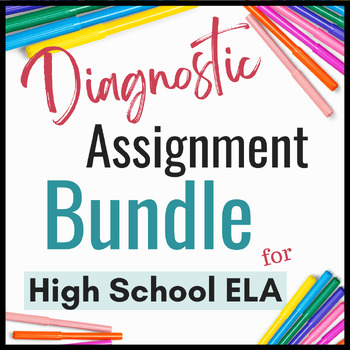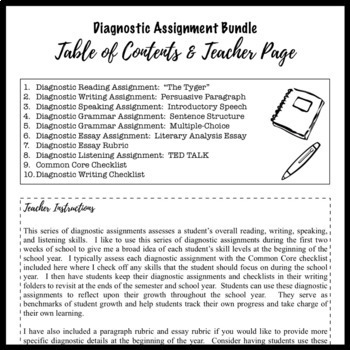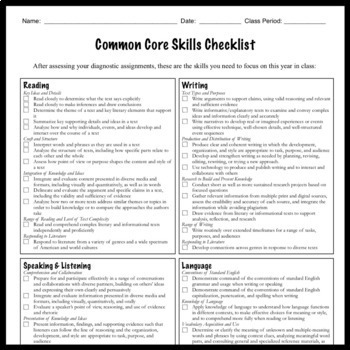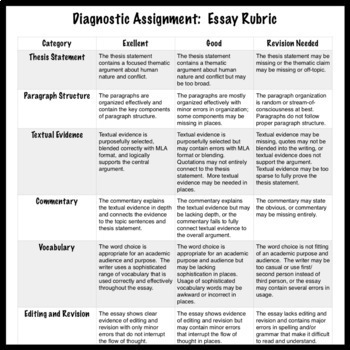Diagnostic Assignment Bundle for High School ELA
- Zip
What educators are saying
Description
This series of diagnostic assignments assesses a HIGH SCHOOL student’s overall reading, writing, speaking, and listening skills at the beginning of the school in order to create a baseline for assessing student growth over the course of the year.
This bundle includes:
1. Diagnostic Reading Assignment: “The Tyger”
2. Diagnostic Writing Assignment: Persuasive Paragraph
3. Diagnostic Speaking Assignment: Introductory Speech
4. Diagnostic Grammar Assignment: Sentence Structure
5. Diagnostic Grammar Assignment: Multiple-Choice
6. Diagnostic Essay Assignment: Literary Analysis Essay
7. Diagnostic Essay Rubric
8. Diagnostic Listening Assignment: TED TALK
9. Common Core Checklist
10.Diagnostic Writing Checklist
Teacher Instructions
This series of diagnostic assignments assesses a student’s overall reading, writing, speaking, and listening skills. I like to use this series of diagnostic assignments during the first two weeks of school to give me a broad idea of each student’s skill levels at the beginning of the school year. I typically assess each diagnostic assignment with the Common Core checklist included here where I check off any skills that the student should focus on during the school year. I then have students keep their diagnostic assignments and checklists in their writing folders to revisit at the ends of the semester and school year. Students can use these diagnostic assignments to reflect upon their growth throughout the school year. They serve as benchmarks of student growth and help students track their own progress and take charge of their own learning.
I have also included a paragraph rubric and essay rubric if you would like to provide more specific diagnostic details at the beginning of the year. Consider having students use these rubrics to grade their own writing as an introduction to course writing expectations.
If you would like to quantify this diagnostic data, consider assigning grades or points to each portion of the diagnostic series and using this data to track student growth throughout the school year.
PERKS FOR YOU
*Join the Bespoke ELA Blog to gain access to 100+ FREE resources that are not here on TpT!
* Be sure to click the "FOLLOW" button that is located next to my picture in the profile so that you can hear about sales, new products, and freebies!
* Don't forget to leave feedback to EARN POINTS that turn into cash towards future purchases!
---------------------------------------------------------------
Related Blog Posts:
Four Back-to-School Diagnostic Assignments for Secondary ELA
Five Ways to Target Commentary for Essay WritingAcronyms for Literary Analysis: A Comprehensive List of Strategies
Characterization Activities for ANY TEXT!
Teaching Students How to Write Commentary for the Literary Analysis Essay
Commentary for Literary Analysis: Four Square Strategy for Success
The Essay Shaping Sheet: Friend or Foe?
8 Ways to Help Students Break Through Writer’s Block
You might also like:
30 MENTOR SENTENCES for Literary & Rhetorical Devices with Writing Application
Crafting Commentary for Literary Analysis
---------------------------------------------------------------
Follow Bespoke ELA for UPDATES, ANNOUNCEMENTS, & FREEBIES





